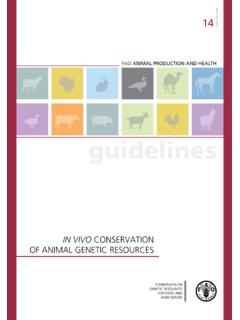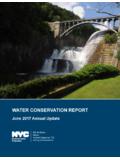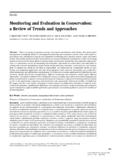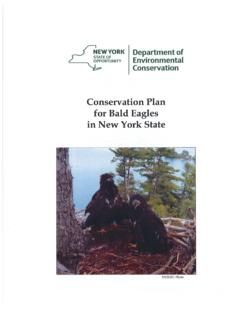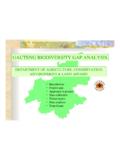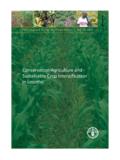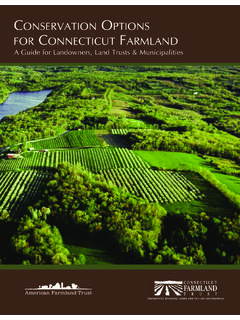Transcription of Drafting CONSERVATION Easements
1 DraftingCONSERVATIONE asementsByJessica E. Jay, , Meadowlark DriveEvergreen, CO 80439 Phone: 303-674-3709 Fax: 2010 CONSERVATION LAW, All rights EasementsDrafting the CONSERVATION easement influences everything about the protected property after theeasement s grant: it guides the landowner s use of the protected property, it guides Land Trust s monitoring and stewardship of the property, and it guidesLand Trust s enforcement of the CONSERVATION easement against theoriginallandownerand all future landowners, s policies will complementdrafting,stewardship,and enforcementof the CONSERVATION Easements it holds, but detailsand requirements specific to that property achieved through the easement s Drafting arecontained in thefinal, recorded deed of CONSERVATION challenge of Drafting CONSERVATION easementslies increating documents that endure and are enforceable for perpetuity, and this requires creatingbothflexibility andfortitudein the document.
2 Two Principles/QuestionsshouldguideALLconser vation easement Drafting :(1)What are the CONSERVATION Purposes/Values of THIS CONSERVATION easement? and(2)How are the CONSERVATION Purposes/Values connected to/impacted by permitted and prohibitedusesand all other provisions of the CONSERVATION easement? theConservation Purposes/ValuesofTHISC onservation Easement:Determining/Defining CONSERVATION Purposes/Valuesof aSpecific CONSERVATION Easement Law:guides and provides our framework for determining/defining CONSERVATION values andpurposes Baseline Inventory:can show all of a property s qualities and characteristics, someof which may bedefined and identified asconservation values/purposesin the CONSERVATION easement; landownersmay seek less breadth than the baseline inventory, or more clarity as to specific CONSERVATION values,which can and should be accomplished through the easement s Drafting (see below).
3 Landowner/Land Trust: together decide what aspects of the property are worthy of protection in thepublic s interest for perpetuity,using as parameters the qualifying law for tax benefits and thebaseline report,together withLand Trust and landowner s observations about the : If CE is to Qualify for aFederalIncome Tax Deduction:Internal Revenue Code/TreasuryRegulations:Qualifying for Income Tax Deduction.(Internal Revenue Code 170(h) (26 USC 170) andTreasuryRegulations (26 CFR )) qualified CONSERVATION contribution satisfies the Internal Revenue Coderequirementsfor a charitable contribution and income tax deduction. A qualified conservationcontribution is a:i. Qualified real property interest , to a qualified CONSERVATION organization , CONSERVATION purposes.
4 (26 USC 170(h)(1)) qualified real property interest is an easement or other interestin realproperty thatunder state law has attributes similar to an easement . (26 USC 170(h)(2)) qualified CONSERVATION organization is either qualified, tax-exempt501(c)(3)charitable organization, which mustgenerally be inthe land CONSERVATION field or have a mission of land CONSERVATION , entity (26 USC 170(h)(3)), and 2010 CONSERVATION LAW, All rights theresourcesandcommitmentto protectthe CONSERVATION values ofthe gift CONSERVATION purposes include the preservation of land foroutdoor recreation or educationfor substantial andregular use for the public; protection of thenatural habitatof fish, wildlife or plants.
5 Preservation ofopen space, including farmland and forestland, where suchpreservation is for the scenic enjoyment of the general public or is pursuant to aclearly delineated governmental CONSERVATION policy and will yielda significantpublic benefit; preservation ofhistorically important landor a certified historicstructure.(26 USC 170(h)(4)) Easement s CONSERVATION purpose(s) must be protected inperpetuity.(26 USC 170(h)(5)). Protected in perpetuity according to the Code and Regulations requires surface miningon the easement property is must subordinate to theright of the easement holder toenforce theterms of theconservation easement. (26 CFR (g)) the CONSERVATION easement sufficient to establish the condition ofthe property at the time of the gift is required, usually in the form of a baselineinventory.
6 (26 CFR (g)) and proceedsfrom sale or conversion if the easement is subsequent unexpected changes in the conditions surrounding the property subjectto easement make impossible or impractical the continued use of the property forconservation purposes, the easement may be extinguished by judicial is entitled to proceeds in proportion to the easement s value. (26 CFR (g)) If CE is to Qualify in Colorado: ColoradoEasement Enabling Act:QualifyingConservation Easement Donation:Afullytransferable interest in real propertyinterest that is a CONSERVATION easementin gross.(CRS seq.)Purpose: Maintaining the landpredominantly in a natural, scenic, or open condition, or forwildlife habitat, or for agricultural, horticultural, wetlands, recreational, forest, or other use orcondition consistent with the protection of open land, environmental quality or life-sustainingecological diversity, or appropriate to the CONSERVATION and preservation of buildings, sites, orstructures having historical, architectural, or cultural interest or value.
7 (CRS ) IfCEis to QualifyforColoradoConservation Easement Tax Credit:Credit against income tax for Colorado taxpayers who donate CONSERVATION Easements .(CRS 39-22-522).A credit is generated from the donation of asingleperpetual conservationeasementingrosswhich must be aqualified CONSERVATION contribution per 26 USC 170(h)(see above).B. How Arethe CONSERVATION Purposes/Values Connectedto/Impactedby Permittedand ProhibitedUses,andOther Provisions of the CONSERVATION Easement? Draft each easement specific to thatproperty and itsdefinedconservation values; 2010 CONSERVATION LAW, All rights reserved-4- Adapt from the model easement options and alternatives appropriate for the specific conservationvaluesand characteristicsof that property; Do not regulate uses just because you can; make sure all permitted and prohibited uses have anexus to the property s definedconservation values,and remember that each use you regulatecarries with it a monitoring and enforcement responsibility,forever, and that thosespecificusesare the only onesyou monitor for and enforce.
8 Be objective in Drafting for the public s benefit, and not subjective as to private benefits or personal opinions byalways substantiating the nexus betweentheuses and purposes; Do not over-regulate where you do not need to, or whereyou may be able to rely onsomeoneelsewhoalready does; Create flexibilityandfortitudewithout impairing protectedconservation valuesor your ability toenforcethe CONSERVATION each easement specific to that property and its definedconservation values(Do notregulate uses just because you can; make sure all permitted and prohibited uses have anexus to the property s protected CONSERVATION values): Rely on themodel easementas a starting point for your draft, but tailoreach easement tothe specific CONSERVATION values and purposes protected by that CONSERVATION easement;do not be afraid to modify, remove, or addcertain provisions if they do or do not apply tothat specific property or its protected values.
9 The model easement should contain optionsand alternative language for different protected CONSERVATION values anddraftingpromptsto consider such alternatives based on the different values protected andthestate of theland eg:if the minerals are partially owned by the landowner, the mineral sectionshould refer to a mineral remoteness inquiry and should anticipate both assembly andfurther severance of these rights,andaddresscontrol and lack thereof over the surfaceimpacts of any explorationor extraction by mineral owners; Consider the purposeandconservation values first and then draft the permitted andprohibited uses: If the purpose and CONSERVATION value of the easement iswildlife habitat protectionONLY and the property is beautiful, but not visually accessible to the public, certainprohibited uses may not apply and ought not to be taken on byLand Trustas amonitoring and enforcement burdenwhen there is no nexus to the purpose or definedconservation values eg:color/materials of permitted buildings, which do not matterto the wildlife;use of alternative energy resources anywhere on the propertyprovidedthey are not inconsistent with thewildlife habitat protection.
10 By the same token,certain uses ought to be controlledbecauseof the nexus between the use and theconservation value eg:no mowing, digging, excavation, etc. in wetlands shown onthe map/Exhibit B; If the purpose and CONSERVATION values of the easement arescenic open spacepursuant to clearly delineated policiesproviding significant public benefitONLY, certain prohibited uses may not apply and ought not to be taken on byLandTrustas a monitoring and enforcement burden when there is no nexus to the purposeor defined CONSERVATION values eg:wildlife-friendly fencing;by the same token,certain uses ought to be controlledbecauseof the nexus between the use and theconservation value eg:earthtone paint colors/exteriors,non-reflective rooftops,alternative energy resources out of view or camouflaged, long as thebuildings/structuresare visible to the public.

